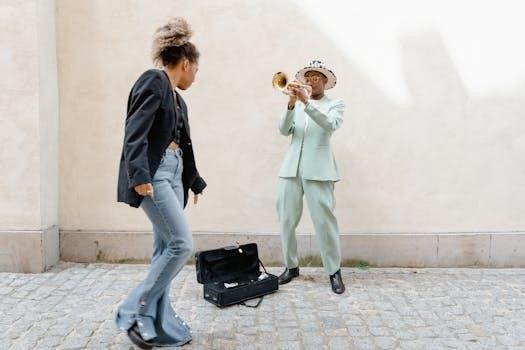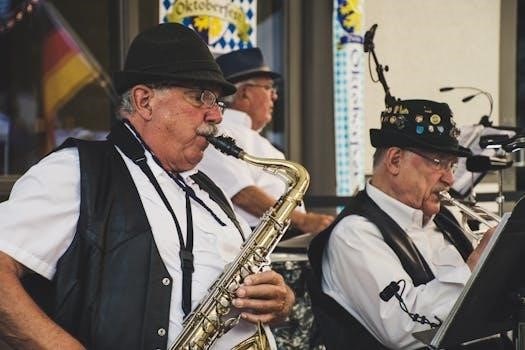Haydn’s Trumpet Concerto in E-flat Major⁚ An Overview
Haydn’s radiant and popular Trumpet Concerto in E-flat Major, Hob. VIIe⁚1, composed in 1796, stands as his last major orchestral work, showcasing the keyed trumpet’s new chromatic capabilities for the soloist.
Historical Context and Composition
Joseph Haydn’s Trumpet Concerto in E-flat Major emerged during a period of significant innovation in instrument design. Composed in 1796, it was written for Anton Weidinger, a trumpeter in the Viennese court. Weidinger was pivotal, as he invented the Klappentrompete, or keyed trumpet, allowing for fully chromatic playing.
Haydn’s concerto fully exploits the technical abilities of this new instrument. At 64, Haydn explored unprecedented sonorities, making the most of the instrument’s capabilities. This collaboration between composer and instrument inventor resulted in a work that pushed the boundaries of the trumpet repertoire. The concerto offered music lovers sonorities never before heard.
Haydn’s work stands as a testament to the creative possibilities when technological advancement meets artistic vision, solidifying its place as a cornerstone of classical music.

The Keyed Trumpet and Anton Weidinger
Anton Weidinger, a Viennese court trumpeter, invented the Klappentrompete, or keyed trumpet, in the late 18th century. This invention paved the way for Haydn’s groundbreaking Trumpet Concerto.
Weidinger’s Invention⁚ The Klappentrompete
Anton Weidinger’s Klappentrompete, or keyed trumpet, revolutionized trumpet playing in the late 18th century. Before Weidinger’s invention, the trumpet was primarily limited to the notes of the harmonic series, making it difficult to play melodically. The Klappentrompete, however, employed a series of keys, similar to those found on a clarinet or flute, to allow the instrument to play chromatically throughout its range.
This innovation opened up new possibilities for composers, as it allowed them to write melodies and passages that were previously impossible on the trumpet. Weidinger’s invention was a significant advancement in the history of the trumpet, and it paved the way for the development of the modern valve trumpet. The keyed trumpet allowed the instrument to play the octave in chromatic steps.
Commissioning of the Concerto
The Haydn Trumpet Concerto in E-flat Major was commissioned by Anton Weidinger, a trumpeter in the Imperial Court Orchestra in Vienna. Weidinger, being the inventor of the Klappentrompete, sought to showcase the capabilities of his new instrument, which could play chromatically. He approached Joseph Haydn, a composer known for his innovative and masterful orchestral works, to compose a concerto specifically for the keyed trumpet.
Haydn, recognizing the potential of Weidinger’s invention, accepted the commission and composed the concerto in 1796. The concerto served as a vehicle to demonstrate the expanded range and melodic possibilities of the Klappentrompete. Weidinger premiered the concerto in 1800, solidifying its place as a landmark composition for the trumpet.

Musical Analysis of the Concerto
The concerto, a favorite in the trumpet repertoire, consists of three movements. Each movement explores the new chromaticism afforded by the keyed trumpet, showcasing Haydn’s masterful orchestration.
Movement I⁚ Allegro
The opening Allegro of Haydn’s Trumpet Concerto in E-flat major is festive and radiant. The movement begins with the orchestra introducing the main themes before they are taken up by the soloist. The trumpet part exploits the full range of the instrument, showcasing the chromatic capabilities made possible by Weidinger’s keyed trumpet. Melodic passages and scalar runs abound, demonstrating the trumpet’s newfound agility. Haydn masterfully balances the orchestral textures with the solo trumpet line, creating a vibrant and engaging musical dialogue. The movement is characterized by its energetic character and memorable themes, establishing a cheerful mood. The innovative writing for the trumpet, combined with Haydn’s skillful orchestration, makes this movement a highlight of the concerto, marking a new era for the instrument.
Movement II⁚ Andante
The second movement, Andante, offers a contrasting lyrical respite. This movement is notable for its radiantly lyrical qualities. The trumpet sings a beautiful, expressive melody, showcasing the instrument’s ability to produce delicate and nuanced tones. The orchestral accompaniment is subtle and supportive, creating a serene atmosphere. The Andante allows the soloist to demonstrate their control and artistry, emphasizing musicality over technical virtuosity. The movement’s simplicity and elegance highlight the emotional depth of the concerto. Haydn’s masterful handling of dynamics and phrasing contributes to the overall beauty and poignancy of the Andante. This slow movement provides a moment of introspection and calm, offering a contrast to the outer movements’ exuberance.
Movement III⁚ Allegro
The final movement, Allegro, returns to a lively and spirited mood, providing a brilliant conclusion to the concerto. This movement transforms the trumpet’s military tendency into pure musical bliss. The trumpet shines with dazzling displays of virtuosity. It features a memorable and catchy theme that is both playful and engaging. The orchestra and soloist engage in a spirited dialogue, creating a sense of excitement and energy. Haydn’s skillful orchestration ensures that the movement is both light and festive. The Allegro showcases the trumpet’s agility and range, leaving the audience with a feeling of joy and exhilaration. It is an indelible finale, solidifying the concerto’s place as a beloved masterpiece.

Availability of Sheet Music (PDF)
The popular Haydn Trumpet Concerto sheet music is readily available in PDF format for free downloads and published editions, catering to both students and professional musicians.
Free PDF Downloads
Numerous websites offer free PDF downloads of the Haydn Trumpet Concerto in E-flat Major, catering to various needs. These include complete scores, individual trumpet parts, and piano reductions for practice. IMSLP (International Music Score Library Project) is a great source for public domain scores, offering various versions of the concerto.
Arrangements for different instruments, like cornet, are also often available. Many free versions are available for download.
While convenient, users should verify the quality and accuracy of free PDF downloads. Some free versions may contain errors or lack essential markings. Always compare with known editions to ensure accuracy before performing.
Consider supporting publishers by purchasing a licensed edition if you frequently use the concerto. However, free downloads are an excellent starting point for study and personal enjoyment. Several versions include cadenzas.
Published Editions
Several reputable music publishers offer high-quality editions of Haydn’s Trumpet Concerto in E-flat Major. These published editions typically feature scholarly editing, accurate notation, and helpful performance notes. Bärenreiter, Boosey & Hawkes, and Breitkopf & Härtel are among the well-known publishers offering this concerto.
These editions often include a full score, a piano reduction for rehearsal, and separate parts for the trumpet and orchestra. Urtext editions, based on the original manuscripts, are also available for those seeking the most authentic version. Published editions are generally more reliable than free online PDFs.
They often incorporate editorial markings and historical context, aiding in interpretation. Investing in a published edition ensures accuracy and supports the ongoing work of music scholars and publishers. Consider versions edited by renowned Haydn scholars for the best possible score. They are a solid resource.

Notable Performances and Recordings
Haydn’s Trumpet Concerto has enjoyed countless performances and recordings, solidifying its place as a cornerstone of the trumpet repertoire. Renowned trumpeters like Alison Balsom and Wynton Marsalis have championed the work, delivering memorable interpretations that showcase its brilliance.
Recordings by these and other celebrated artists, such as Gábor Tarkövi with conductor Marc Minkowski, offer diverse perspectives on the concerto. Performances often highlight both the technical demands and the lyrical beauty of Haydn’s writing. Many orchestras feature the concerto regularly.
Live performances capture the excitement and energy of the work, while studio recordings provide a polished and refined listening experience. The concerto’s enduring popularity ensures that new performances and recordings continue to emerge. Each artist brings their unique style and approach, creating a rich tapestry of interpretations. Audiences around the world appreciate it.
